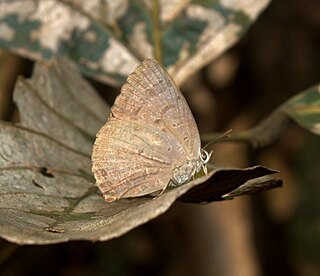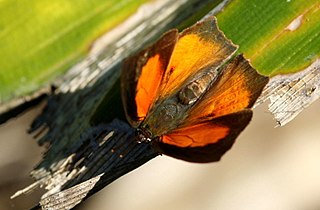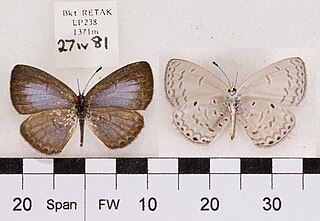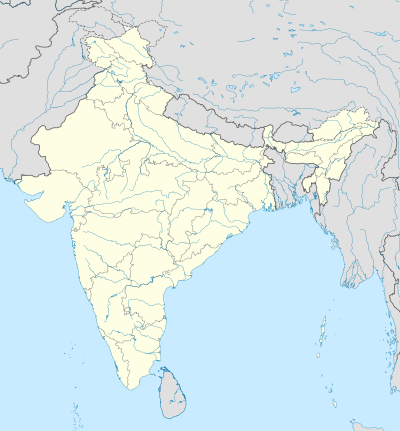
Gomalia elma, also known as the marbled skipper or African marbled skipper, is a species of hesperiid butterfly. It is found in Africa and parts of Asia.

Zizina otis, the lesser grass blue, is a species of blue (Lycaenidae) butterfly found in south and southeast Asia. The species was first described by Johan Christian Fabricius in 1787. The lesser grass blue is often misidentified as Zizina labradus, the common grass blue.

Zizula hylax, 'the Tiny grass blue' is a species of blue butterfly.

Miletus symethus, the great brownie, is a small butterfly found in India that belongs to the lycaenids or blues family. The species was first described by Pieter Cramer in 1777.

Bindahara phocides, the plane, is a small butterfly found Indomalayan and Australasian realms that belongs to the lycaenids or blues family.

Chilades parrhasius, the small Cupid, is a small butterfly that belongs to the lycaenids or blues family. It is found in Nepal, southern Turan, southern Ghissar, Iran, Afghanistan, Pakistan, Sri Lanka, United Arab Emirates, Oman and southern, central and north-west India.

Jamides celeno, the common cerulean, is a small butterfly found in Indomalayan realm belonging to the lycaenids or blues family. The species was first described by Pieter Cramer in 1775.

Acytolepis puspa, the common hedge blue, is a small butterfly found in Cambodia, India, Myanmar, Thailand, Malaysia, Singapur, Yunnan, Taiwan, Sri Lanka, Philippines, Borneo and New Guinea that belongs to the lycaenids or blues family. The species was first described by Thomas Horsfield in 1828.

Prosotas aluta, the banded lineblue, is a species of blue butterfly (Lycaenidae) found in Asia. The species was first described by Herbert Druce in 1873.

Arhopala abseus, the aberrant oakblue or aberrant bushblue, is a species of lycaenid or blue butterfly found in Asia.

Arhopala atrax, the dark broken-band oakblue or Indian oakblue, is a species of lycaenid or blue butterfly found in the Indomalayan realm.

Zesius chrysomallus, the redspot, is a species of lycaenid or blue butterfly found in Sri Lanka and India.

Hypolycaena nilgirica, the Nilgiri tit, is an uncommon species of lycaenid or blue butterfly found in Asia, especially in the lowland regions to mid-hills of India and Sri Lanka.

Deudorix perse, the large guava blue, is a species of lycaenid or blue butterfly found in the Indomalayan realm. It was described by William Chapman Hewitson in 1863. The larva feeds on Randia dumetorum.

Curetis acuta, the angled sunbeam, is a species of butterfly belonging to the lycaenid family. It is found in Indomalayan realm. Curetis acuta is sexually dimorphic, the sexes differing in dorsal coloration of the wings, however their ventral wings are similar and of silver color which reflects sunlight. The reflection of light by silver ventral wings plays a role of signalling during flight, camouflage while at rest or during hibernation, and lowering body temperatures by reflecting the sunlight.

The blue tit is a species of lycaenid or blue butterfly found in parts of South Asia and Southeast Asia. It was traditionally called Chliaria kina but the genus Chliaria is merged into Hypolycaena by many recent authors.

Rathinda is a butterfly genus in the family Lycaenidae. It consists of a single species, Rathinda amor, the monkey puzzle, found in Sri Lanka and India.

Zeltus is a butterfly genus in the family Lycaenidae, the blues. It is monotypic containing the species Zeltus amasa, the fluffy tit, a small butterfly found in Indomalayan realm. The butterfly is found in India, specially the Western Ghats, Sikkim to Assam. It can also be found in Myanmar, Thailand, West Malaysia, Sumatra, Borneo, Singapore, Java and the Philippines.

Catochrysops strabo, the forget-me-not, is a small butterfly found in Asia that belongs to the lycaenids or blues family. The species was first described by Johan Christian Fabricius in 1793. It is found in Sri Lanka, India, from Sikkim to Indochina and in Sundaland, Sulawesi and the Philippines.

Monodontides musina, the Swinhoe's hedge blue, is a butterfly of the family Lycaenidae. It is found in South-East Asia, including India.























